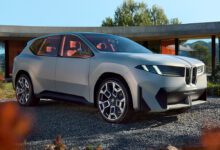
The Audi A6 Avant e-tron concept is a vision of the family car of the near future.
The all-electric Audi A6 Avant e-tron concept is a new forerunner of the future Audi A6 family with electric drive. The focus is on everyday functionality in an elegant package. The car will debut later this year and confirms the brand's commitment to the development of electric mobility.
All-electric 2024 Audi A6 Avant e-tron concept
The design of the Audi A6 Avant e-tron concept demonstrates its origins as a representative of the successful Audi A6 series, but also shows how it can make an evolutionary leap into the e-tron era. This is evidenced by details such as the continuous light bar at the rear, as well as the large, closed Singleframe grille, the lower edge of which is flanked by low-to-ground air intakes that cool the drive, battery and brakes.
The design has no sharp edges, allowing the convex and concave contours of the Audi A6 Avant e-tron Concept to blend seamlessly. The combination of 22-inch wheels and a low ride height with a flattened cabin and wide roof arch gives the car a sporty look and character. The flat roof arch features a unique D-pillar sloping rearward design. Like the similarly sized Audi A6 Sportback e-tron concept, the 4.96 m long, 1.96 m wide and 1.44 m high body is classified in the premium automotive class.
Engineers and designers spent a lot of time working on the body of the A6 Avant e-tron concept to achieve the best possible frontal performance while maintaining the character of the Avant models. Thanks to thousands of hours spent in the wind tunnel, a drag coefficient of 0.24 was achieved - just two hundredths more than the Sportback, despite the Avant's characteristic high roofline. In practice, this means less energy consumption, which in turn can have a positive effect on flight range.
The new Audi A6 Avant e-tron will debut later this year, confirming the brand's dynamic development and commitment to electromobility.
Platform of the future
The A6 Avant e-tron concept model, like the concept models of the sphere, is built on the modern PPE platform (Premium Platform Electric), which debuts for the first time this year in the Q6 e-tron and Q4 e-tron models and will form the basis for all future electric models Audi.
Thanks to this, Audi stands out with its electric models, offering a range of electric models comparable, and often even greater, than in the case of models with an internal combustion engine, and reducing the time spent on charging to a minimum. Thanks to the PPE platform, depending on the drive and model variant, the production version based on the Audi A6 Avant e-tron concept can in the future offer a range of more than 700 kilometers (WLTP standard). This is possible thanks to an 800 V system and charging power of up to 270 kW.
The PPE platform is universal, its sizes can be changed and used in many model lines. This allows models with lower power consumption to be equipped with a smaller and lighter battery. Moreover, using the entire vehicle base allows for a relatively flat battery pack layout. This is not only important for vehicles with dynamic architecture, but also ensures quattro drive.
Modern lighting
Digital Matrix LED and OLED technology is not only compact, but also provides a high degree of brightness for both headlights and taillights, as well as customizable lighting characteristics. Thanks to three high-resolution LED projectors in the body, the A6 Avant e-tron concept can project light animations onto the ground that serve as a welcome to passengers or warning symbols for road users.
Four more high-resolution LED projectors at the corners of the car serve as direction indicators. If, for example, the Audi A6 Avant e-tron concept is parked in front of a wall while charging, the driver and passengers can spend time playing a video game projected onto the wall using Matrix digital LED headlights. At the rear of the concept car, next-generation digital OLED elements integrated into a continuous light bar act as a display that generates customizable digital light signatures and dynamic animations. The three-dimensional architecture of digital OLED elements creates light animation with extraordinary spatial effects.
Source: Audi








